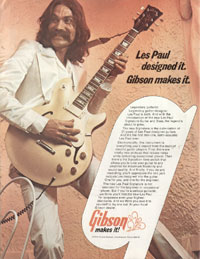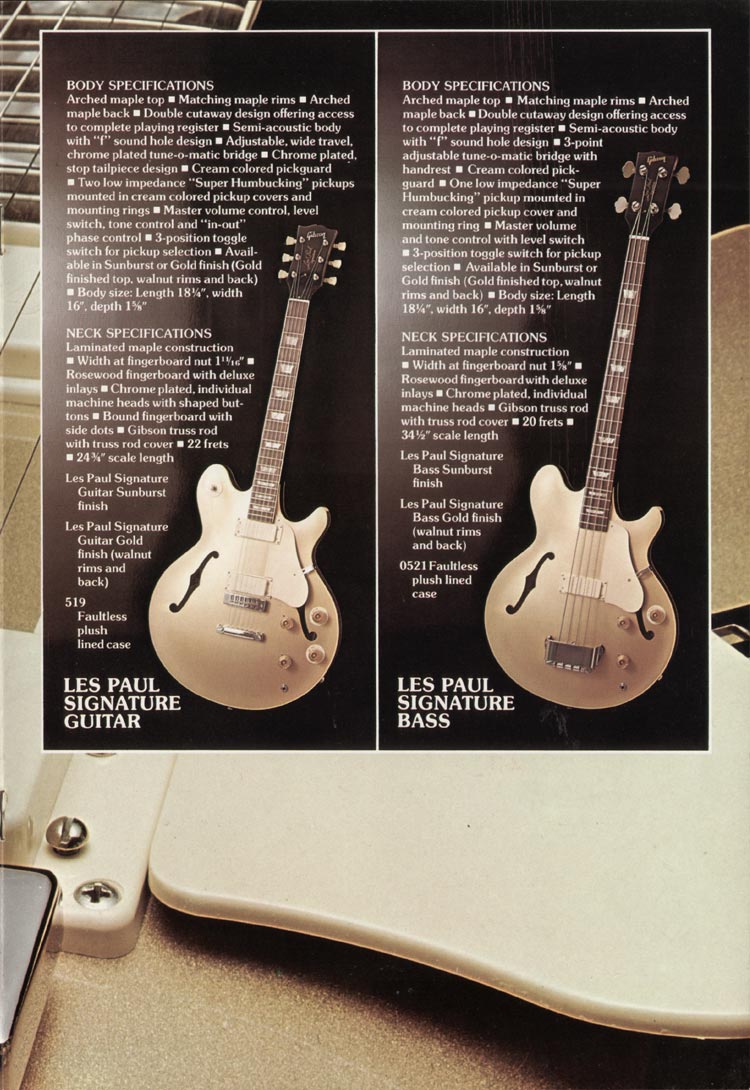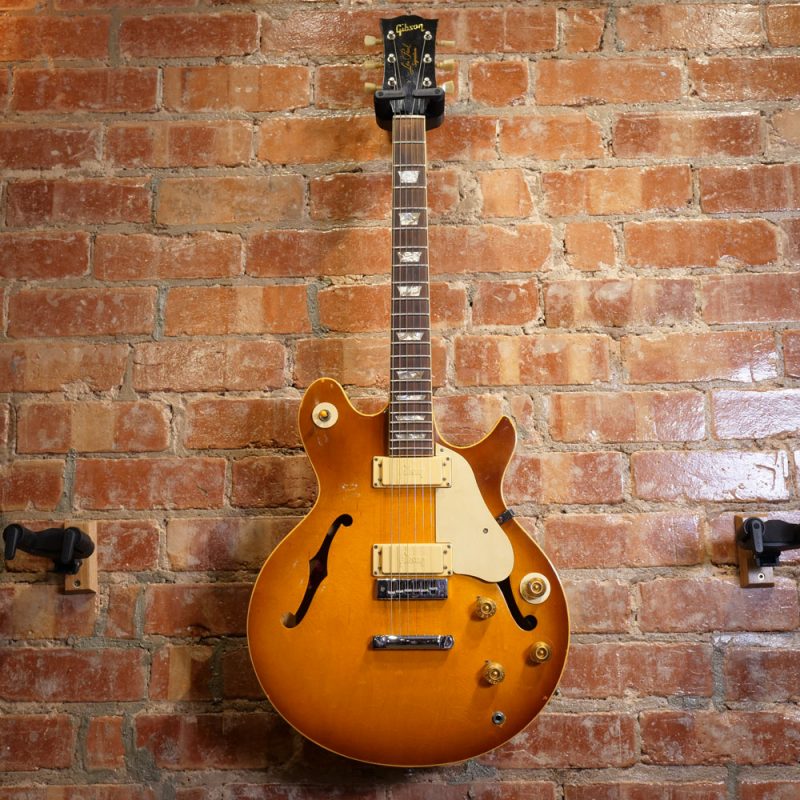-
"Les Paul Signature".... I never knew this LP actually existed! Should be popular among Jazz or Fusion players... no?
There's one at Hendrix Guitars in Italy (Liguria, Genoa region). Might go and try it one day...
-
12-10-2023 12:31 PM
-
I owned the Ephiphone version twice -- just sold one a month ago.
a) If you like the feel of the ES-330 you will like the feel of the LP Sig. Unlike the 330 the LP Sig has a "pier" under the bridge and stop-piece, giving it a more "even" quality and more sustain than a fully-hollow guitar. Because it is only in that spot instead of tail-to-neck it's about a pound lighter than the ES-3X5.
b) The low-impedance pickups with the built-in three-position transformer mean that these guitars have a wide variety of clean tones at different volumes. Lotta people would say that sounds like "great guitar for jazz." It worked for me.
c) For better or worse all those tones come with different volume levels. If you want different volumes, voila. If you want different tones at the same volume attention is required.
I dug it. The Epi version -- with its poly finish -- delivered tons of tones for modest cost and stood up nicely on summer stages. Maybe someday I'll own one again.
All the best with your quest.
-
Thanks for the info.
 Originally Posted by Sam Sherry
Originally Posted by Sam Sherry
For me one or two "favourite tones", one at low-mid volume and one at mid-high wolume would be fine...
-
I had one for about 20 years, roughly 1975 - 1995. Here's what I wrote about it many years ago:
The Les Paul Signature was the only thin-line hollow-body Les Paul GIBSON ever made, and it had definitely not been a hot seller. They only made them for 2 or 3 years in the early ‘70s. By the time I had identified it as the right guitar for me, the model had already been discontinued. However, I was able to locate a used one in a music store and purchased it for $375. I replaced the stock KLUSONS with nickel-plated GROVERS. (I like SCHALLERS better, but that particular store didn’t carry them.)
The Signature is an odd guitar in a lot of ways. Cosmetically, the guitar is much like an old Les Paul Standard, with metallic gold top, cream-colored pickguard and control plates and a bound rosewood fingerboard with trapezoidal pearl inlays. The body shape and construction are basically patterned after the ES-335 design. However, the double cutaways are asymmetrical - the bass-side cutaway is rounded and joins the body at the 16th fret (like on the ES-330 model), while the treble-side cutaway is standard Les Paul. Also, the solid center block is square rather than rectangular; it covers the area under the wide-travel ‘tune-o-matic’ bridge and ‘stop’ tailpiece but doesn’t extend further toward the end pin and the neck heel as it does in a 335. The neck is made of 3-piece laminated maple as opposed to the more typical mahogany. The electronics are a major departure from the norm, too. The two low-impedance Super Humbucking pickups are encased in cream colored plastic covers embossed with the GIBSON logo surrounded by matching 4-way adjustable mounting rings. The control layout looks like the standard Les Paul setup, but it isn’t! It consists of a 3-way toggle switch for pickup selection, a master volume control, a master tone control, a phase switch, and an unusual 3-position level control (intended to enable ‘tuning’ the guitar to any amplifier - bass rolloff @ 50, 250 & 500 Hz). Okay, I’ve been saving the best for last: The guitar has 2 output jacks! One is high impedance via an internal passive transformer for use with normal guitar amps, while the other is low impedance for simultaneous direct feed into a console. Whoa!
The Les Paul Signature was far from a commercial success. And, in spite of its relative rarity, it’s not exactly a vintage collectable either, though it does seem to have recently garnered a certain cult status.
-
Well, learned a bunch today about a model of guitar that I've only seen a photograph of once, previously.
-
The low impedance pickups have a great sound. I have the more 'common' Les Paul Recording. They sound more like a large bobbin single-coil than a regular humbucker.
-
I have a Polytone Mega Brute amp, it has two inputs, one for high impedence (guitar) and one for low impedence (accordion, keyboard, etc.). Would be a good match!? It's a pretty expensive guitar, though (6000+ Euros); I might just go one day and have a try (a few hours drive from where I am). Still I'm quite surprised this LP didn't appeal, that much, to Jazz (and surrounding styles) guitarist...
-
At some point they had sunburst versions too, both "tobacco sb" and a lighter (iced tea sb)? I think they're more visually appealing, if one cares about that. I wanted one when they came out, I still remember the ad. Check out his classic "Saturday Night Fever" 70's suit. They also had a bass version. Three pics below with some info.



-
The bass version now essentially lives on as the Epiphone Jack Casady signature bass and has done quite well.
 Originally Posted by Woody Sound
Originally Posted by Woody Sound
Sent from my iPhone using Tapatalk
-
”Les Paul designed it, Gibson makes it”.
So it is the first Gibson that Les Paul designed! Or second, Recording model could have been the first? The first Les Paul was designed by Ted McCarty and the Gibson team.
-
I was never a fan of this guitar even though I like both Les Pauls and ES Thinlines. This was during Norlin Era Gibson, which I really didn’t care much for either.
I guess it all depends on your likes and needs as well.But Gibson at this point was not at its best for desired instrument building, and used a bunch of cost cutting measures to build their instruments.
-
There is also another hollowbody Les Paul, the ES Les Paul, made from 2014-2016. One quirk with this model is that some don't have f-holes.
ES-Les Paul - Wikipedia
-
Had one for years and loved it despite the design flaws.
I loved the neck joint and cutaway. Neck joins the body in the sweet spot ...not like a 335.
This works for me because my picking hand is over the sweet spot of the neck pickup.
On the 335 ....it's too plinky for me between the 2 HB's.
Offset cutaway gives full access to the top notes on the instrument. (unlike a 330)
The innards allows for some feedback supression but also could be tweaked to generate sustain without feedback
Just the fundamantal tone through the right amp. Certain nights it was magical.
I've owned 2 and searched for and rejected a couple more. The neck angle is off. Maybe it was ok out of the factory.
Maybe the top sank over the years from the internal bracing.
Regardless ...couldn`t get it low enough with tension..... it bowed.
Thought to change the awful untunable cast iron harmonica bridge that rocked when you touched it.
An ABR is too tall because of the shallow neck angle. I actually had a tech route the top to allow an ABR to get in there.
It helped but by then I decided to sell it
Hope this helps.
oh ...I switched out those pickups too ....too brittle




 Reply With Quote
Reply With Quote







Melody between melody
Today, 03:25 AM in Chord-Melody